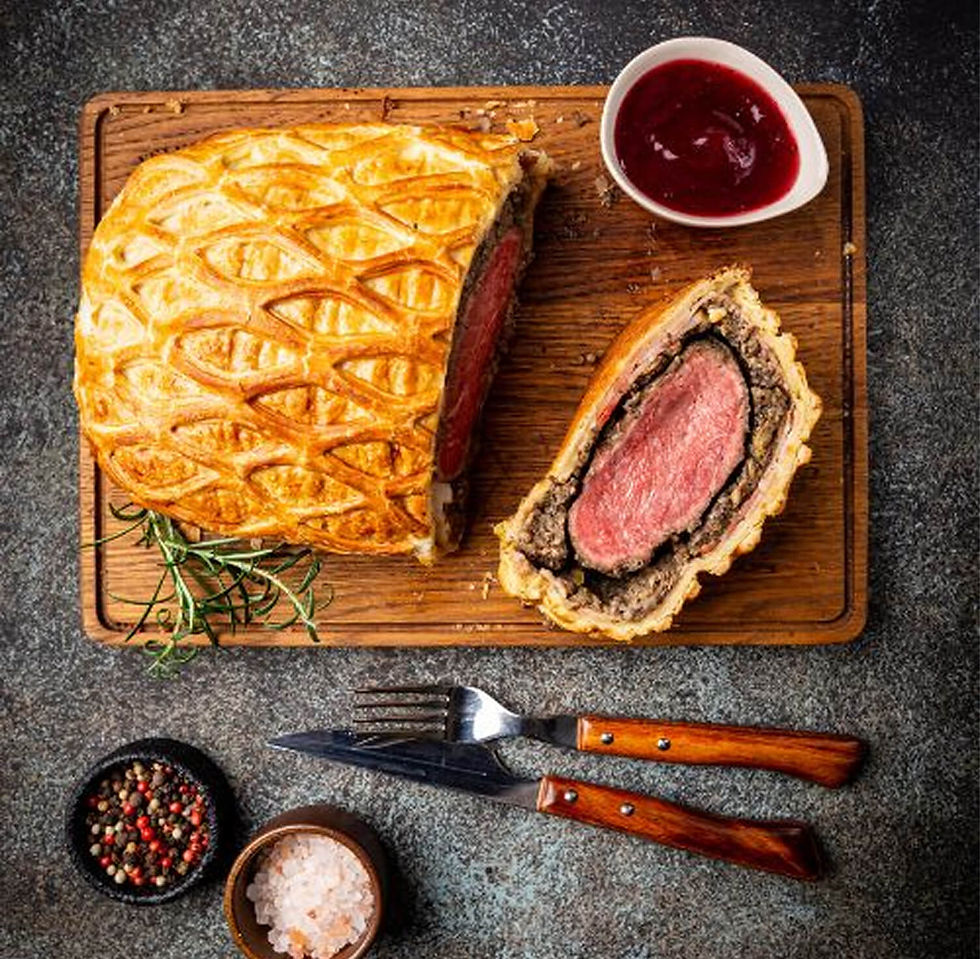Climbing the 40s — How Taking Climate Action Has Shifted Our Diets
- Chef Rod

- May 2
- 5 min read
Updated: May 5

Hey Skinny Readers — how are you all doing? If you’re in South Africa, I hope you enjoyed a well-deserved break on Worker’s Day! Oh, and big shoutout to my parents, Ama and Ada, who just celebrated their 58th wedding anniversary — wow, what a milestone!

April really spoiled us with so many holidays. But guys... I still can’t believe I’m climbing into my 40s! And honestly? I’ve never felt stronger. I truly believe that anyone in their 40s, 50s, or even 60s can become stronger than ever before.

Research shows that most people experience a noticeable decline in muscle strength and overall health starting around age 35 to 40. But according to Elizabeth Quinn, “Strength training is the only type of exercise that can substantially slow — and even reverse — the decline in muscle mass, bone density, and strength that were once seen as inevitable consequences of aging.”
This week’s blog dives into how climate action and healthier eating habits can go hand-in-hand — helping us fight climate change, boost our well-being, and gain strength while doing it. Think of it as a mission for health, wealth, and overall happiness.
Taking Care of Our Planet’s Health

According to the World Health Organization, by 2030, climate change-related health costs are projected to reach between USD 2 billion and 4 billion per year. That’s mind-blowing. Climate change is not only damaging the planet — it’s putting our own health at serious risk. We’re talking pollution, rising food insecurity, increased risk of infectious diseases, extreme heat, floods, droughts… the list goes on.
But the science is crystal clear: reducing greenhouse gas emissions by phasing out fossil fuels and investing in sustainable energy, transport, and food systems will lead to healthier lives, cleaner air, better diets, and even more physical activity.
Jeez, Skinny Readers — that’s just six years away! So let’s look at what’s being done to tackle climate change, and how we can each play a part. Here are three game-changing actions with immediate health benefits:
Phasing Out Fossil Fuels

The public benefits of climate action far outweigh the costs. The Paris Agreement alone could save millions of lives worldwide by 2050, just by reducing air pollution.
Let’s break it down: Fossil fuels — coal, gas, and oil — are the main culprits behind greenhouse gas emissions. They not only drive climate change but also pollute the air we breathe, leading to respiratory diseases, cardiovascular problems, lung cancer, and even neurological disorders.
So, what can we do? Let’s talk renewable energy — wind, solar, and beyond. These sources give us a double win: cleaner air and fewer emissions.
Fun fact: People who cycle daily produce 84% lower carbon emissions from all their travel compared to those who don’t. Time to dust off that bike!
Shifting to Healthier Diets

Skinny Readers, what we eat — and how our food is produced — affects both our health and the environment. The biggest contributors to food-related emissions? Land-intensive animal products like red meat, dairy, and farmed shrimp.
By contrast, plant-based foods — fruits, vegetables, whole grains, beans, and nuts — have much lower emissions. Doesn’t that make you want to shift to a more balanced, eco-friendly diet? One that can fight climate change and improve your health at the same time?
Tracking Habits & Cutting Out Food Waste

Here’s a surprising truth: What you eat is far more important than how far your food has traveled or how much packaging it has. Transport and packaging only make up a small portion of a food item’s total greenhouse gas emissions.
So let’s rethink how we buy, prepare, and dispose of our food. Wasting food = wasting the energy, water, and fertilizer used to produce, package, and transport it.
Let’s commit to buying only what we need, minimizing waste, and using our resources wisely. Next time you go shopping, ditch the plastic and grab your reusable Woolies shopping bag. Together, let’s become food heroes!
Climbing into my 40s has given me a whole new appreciation for this planet. Come on, Skinny Readers — I don’t want to live on Mars, do you?
To truly thrive here, we’ve got to take care of the Earth — and ourselves. Every decision we make, every bite we take, impacts climate change.
Personally, I’ve realized I need to focus more on strength training — not just to maintain my signature skinny form, but to support muscle mass, bone density, and overall health as I grow older.
So to wrap up this week’s blog, here’s my message:

🌍 The planet has spoken.
💪 Your body is listening.
🌱 It’s time to act.
I’m leaving you with a plant-based recipe from my book — one that’s climate-friendly, nutrient-packed, and will leave your taste buds dancing. They say “Never trust a skinny chef”… but after this, I think you just might!
Barley and Butternut Curry

There were rare occasions when my sister-in-law, Tshepiso, would cook at gather ings. In our family my brother Joel and I would do most of the cooking. But damn, when she decides to take over the kitchen, she always makes the meanest curry. One can never go wrong with a tasty curry.
Barley hosts various health benefits, such as improved digestion, weight loss, lower cholesterol and improved heart health.
Butternut is high in fibre, potassium, vita mins like B6 and C, minerals, antioxidants, and is low in carbohydrates. Coconut milk contains proteins and saturated fats which contribute to building body strength, stimulates the metabolism, and may benefit people with high cholesterol.
Ingredients
1 cup pearled barley
1 onion, finely diced
2 garlic cloves, crushed
2 tablespoons olive oil
2¼ cups coconut milk
½ teaspoon curry powder
1 lemon grass stick, crushed
½ teaspoon garam masala powder
¼ teaspoon ground coriander
¼ teaspoon ground ginger
¼ teaspoon ground cayenne pepper
¼ teaspoon salt
1 handful of baby spinach
4 cardamom pods • 8 – 10 coriander seeds
100g butternut, cubed
100g cooked edamame beans
Serves 4
Method
In a medium-size pot add olive oil, onions and garlic and sauté until onions are transparent.
Add all the spices and lemon grass and cook for a further 5 minutes, then add the coconut milk and bring to the boil over medium heat.
Once at a low boil, turn the heat to low and add the barley to cook in the spiced coconut milk. Stir regularly to keep the milk from scalding on the bottom.
While the barley cooks, prepare the edamame beans and butternut. Place the edamame beans in a small pot of salted water, enough to cover the beans, and cook on medium heat until soft. Season and drizzle olive oil over the cubed butternut and roast in the oven at 350°C/180°C until golden brown.
As the coconut milk begins to thicken and reduce, test the barley to see if it’s done. If the barley is still too hard, add some additional coconut milk to keep it from getting too dry while it is cooking.
Continue to add small amounts of coconut milk as needed, until the barley is al dente, and the coconut milk is still creamy.
Add the cooked butternut, baby spinach and edamame beans to the barley and stir over a low heat, adding any additional coconut milk to maintain the right consistency. The end result should be creamy and a bit runny, not thick and sticky.
Remove the cardamom pods before serving and enjoy.
Thanks for tuning in — save our planet, stay healthy, and most importantly, stay skinny. Same time, same place next week!
Creative Director : Shadre Leonard
1
Searing the Beef
Sear beef fillets on high heat for 2 minutes per side to form a golden crust. Let it cool before proceeding to keep the beef tender.
1
Searing the Beef
Sear beef fillets on high heat for 2 minutes per side to form a golden crust. Let it cool before proceeding to keep the beef tender.
1
Searing the Beef
Sear beef fillets on high heat for 2 minutes per side to form a golden crust. Let it cool before proceeding to keep the beef tender.
1
Searing the Beef
Sear beef fillets on high heat for 2 minutes per side to form a golden crust. Let it cool before proceeding to keep the beef tender.
Notes



1
Season the good fresh beef fillets with salt and black pepper. Heat olive oil in a pan over high heat and sear the fillets for 2 minutes per side until it fully browned. Remove the beef from the pan and brush with a thin layer of mustard. Let it cool.



1
Season the good fresh beef fillets with salt and black pepper. Heat olive oil in a pan over high heat and sear the fillets for 2 minutes per side until it fully browned. Remove the beef from the pan and brush with a thin layer of mustard. Let it cool.



1
Season the good fresh beef fillets with salt and black pepper. Heat olive oil in a pan over high heat and sear the fillets for 2 minutes per side until it fully browned. Remove the beef from the pan and brush with a thin layer of mustard. Let it cool.



1
Season the good fresh beef fillets with salt and black pepper. Heat olive oil in a pan over high heat and sear the fillets for 2 minutes per side until it fully browned. Remove the beef from the pan and brush with a thin layer of mustard. Let it cool.
Instructions
Quality Fresh 2 beef fillets ( approximately 14 ounces each )
Quality Fresh 2 beef fillets ( approximately 14 ounces each )
Quality Fresh 2 beef fillets ( approximately 14 ounces each )
Beef Wellington

Beef Wellington
Fusion Wizard - Rooftop Eatery in Tokyo
Author Name

Beef Wellington is a luxurious dish featuring tender beef fillet coated with a flavorful mushroom duxelles and wrapped in a golden, flaky puff pastry. Perfect for special occasions, this recipe combines rich flavors and impressive presentation, making it the ultimate centerpiece for any celebration.
Servings :
4 Servings
Calories:
813 calories / Serve
Prep Time
30 mins
Prep Time
30 mins
Prep Time
30 mins
Prep Time
30 mins



Comments